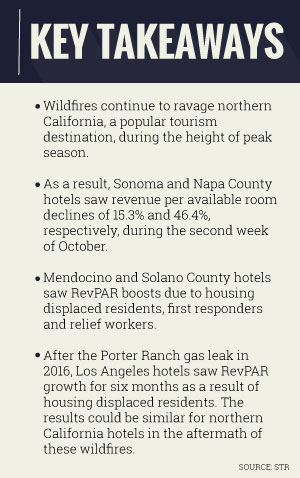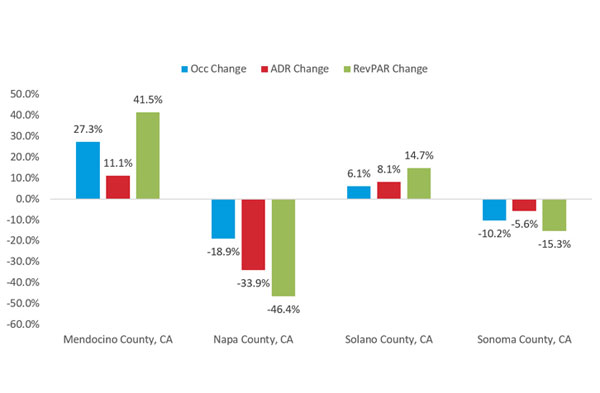✕

Column: industry Tag: Wildfires,hotel performance,Northern California Published: 2017-10-25 11:18 Source: Author:

BROOMFIELD, Colorado—During what is typically peak tourism season, hotels in California’s wine country have taken big hits because of the devastation of wildfires, many of which are only now beginning to come under control.
Since an outbreak of wildfires began on 8 October in northern California, about 245,000 acres have burned, 8,400 structures destroyed and at least 42 people were killed, according to news reports.

The largest fires broke out in northern California (see the affected regions on this map), and have continued to roar over the last few weeks, destroying homes, wineries and hotels in their path. Inbound tourism has been impacted, as our analysis will show. But, as Hotel News Now’s Bryan Wroten reported, in some areas outside of the immediate danger zones, hoteliers are stepping up to provide much-needed hospitality?to first responders and displaced residents.
This analysis will look at the impact from the wildfires on hotel performance in four northern California counties, and provide some context for what that impact may be in the longer term.
Northern California fires
The four largest fires in northern California have been the Nuns, Atlas, Tubbs, and Redwood fires, which combined have burned nearly 180,000 acres in four counties: Napa, Solano, Sonoma and Mendocino. The fires started during the end of the peak season for this area, which typically runs from May through October and peaks in September/October during the grape harvest.
We looked at RevPAR for hotels in this area during the first two weeks of October, and how it compared to the same period last year. The first week, 1-7 October, was before the fires started; and the second week coincides with the start of the fires.
During October, Sonoma County hotels typically report occupancy in excess of 81%, underscoring the popularity of the area during peak grape season. Comparing the first two weeks of October this year and last, Sonoma County saw a RevPAR decrease of 15.3%, largely due to a 10.2% drop in occupancy.

During October, Napa County typically reports occupancy in excess of 81%. Compared to last year, Napa County has seen a RevPAR decline of 46.4%, driven by an 18.9% drop in occupancy and average daily rate that was 33.9% lower. Napa County tends to rely more on tourism, while Sonoma is more balanced with a greater degree of corporate demand.

Two other large counties in northern California affected by the fires are Mendocino and Solano counties, both of which are more residential than tourism-driven and generally have a lower RevPAR than the other affected counties. Since the outskirts of these counties were outside of the path of the fires, there was an influx of people—including displaced residents, news crews, insurance adjusters, federal aid workers and firefighters—who sought shelter at hotels there, thus driving up RevPAR.
Mendocino County realized the largest boost in RevPAR for the second week of October—up 41.5% to $97. In October, hotels in the county usually see a RevPAR of $60. Solano County hotels also realized a boost in the second week of October this year. RevPAR was at $90, an increase of 14.7% over the typical October RevPAR of $58.



(Source: STR)
Moving forward
It might be some time before we start to fully see the effects these fires have on the region, but they will be long-lasting. Napa and Sonoma counties produce some of the largest amounts of California wine and are a big tourism destination. We saw rate increase in two of the four affected counties we analyzed, but it will be interesting to keep an eye on this moving forward as some hotels in the area have begun to charge only a flat rate for displaced residents.
While there is no direct comparison to these events, the Aliso Canyon gas leak (also known as the Porter Ranch gas leak) in 2015 and 2016 in Los Angeles can provide some idea of what the long-lasting effects might be. The large impact in that disaster was double-digit RevPAR growth for six months after the incident in the two affected submarkets of Los Angeles where displaced residents were housed. We might expect something similar to happen in the affected counties during the rebuilding process as competition for construction crews builds.
Previous:Outrigger Hotels and Resorts to Rebrand and Renovate Waikiki Beachcomber
Next:Whitbread has 100,000-room goal for Premier Inn in UK
Hot key words
Hot Products
Popular Vendors